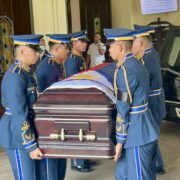Breastfeeding in the era of climate change

Early this August, I was privileged to speak at the 2024 Breastfeeding Congress organized by the Philippine Pediatric Society and the Chinese General Hospital. Each year, to mark World Breastfeeding Week, health professionals and advocates gather to discuss the latest science, policy, and updates on this practice.
Breastfeeding is perhaps one of the cheapest yet most effective public health interventions. It is considered “the first vaccine” because of its clear benefits to improve the immunity of infants against infectious diseases. Breastmilk alone already meets babies’ full nutritional requirements in the first few months—hence exclusive breastfeeding is prescribed up to six months of age.
Interestingly, even during the pandemic, evidence revealed that more infants were at risk of dying from lack of breastfeeding than from the virus itself. A 2016 global study of 153 countries concluded that exclusive breastfeeding reduces infant mortality by 88 percent.
Beyond infancy, breastfeeding promotes children’s cognitive development, which is vital to fully enjoy life’s opportunities. Research also showed that it reduces the risk of chronic noncommunicable diseases such as obesity and diabetes in childhood and adulthood. Breastfeeding is good for mothers too, reducing their risk of breast and ovarian cancer, type 2 diabetes, and hypertension.
Last year, a landmark report in the international medical journal The Lancet declared breastfeeding as “crucially important, but increasingly challenged in a market-driven world.” What the paper failed to ask was, “What is the future of breastfeeding in a warmer world?” The climate crisis can no longer be ignored, even by health and nutrition advocates. The World Health Organization (WHO) even declared it as one of the biggest global health threats in the 21st century.
Climate change impacts human health in different ways—from driving infectious disease outbreaks to causing surges in heat stroke incidence. It also affects all people throughout the entire lifespan—including babies. Infants are particularly susceptible to climate change, which can increase their risk of dehydration, diarrhea, and infectious disease. Hence, now more than ever, public health interventions for the care of infants must be further intensified, including the practice of breastfeeding which, without a doubt, is a protective measure against climate change.
But climate change can reverse progress achieved as a result of widespread breastfeeding. One study in Kenya found that increased exposure to heat among babies can injure their skin and mouth, which makes breastfeeding an uncomfortable experience. Under extreme heat conditions, mothers who just gave birth endure a longer healing period, which can make them practice breastfeeding less and which also affect the quality of the breastfeeding experience overall.
Worse, mothers may resort to commercial milk formula that, in disaster settings, can make the preparation of milk formula risky because of unhygienic conditions and lack of clean water.
The health community must therefore ensure that, in the era of climate change, a strong breastfeeding culture exists and remains in our society, while also pushing for protections against heat, floods, and other climate disasters that can endanger breastfeeding frequency and quality.
Apart from its climate adaptation function, breastfeeding can also be viewed as a climate mitigation practice, as it can help reduce greenhouse gas emissions and slow the progression of climate change. One study conducted by the Australian National University used the Green Feeding Climate Action Tool, which estimates carbon footprints associated with the consumption of commercial milk formula among infants aged under 6 months. Globally, milk formula use is estimated to emit greenhouse gases from cows amounting to around 5.9 to 7.5 billion kilograms of carbon dioxide equivalent each year—which is like cutting up to approximately 341 million trees. Another study concluded that milk formula produces 38 percent more carbon than breastfeeding.
Given these numbers, a paper recently published in the Bulletin of the WHO concluded: “Achieving global nutrition targets for breastfeeding would realize far greater reductions in greenhouse gas emissions than decarbonizing commercial milk formula manufacturing.”
In conclusion, while breastfeeding is a climate adaptation for health, it also needs to be “climate-proofed” to adapt to climate change, sustain global progress, and benefit the health of populations. By being a climate mitigation measure, it is not only an effective public health intervention, but also a promising planetary health solution—one that saves not only human lives but the planet, too.
Renzo R. Guinto, M.D., Dr.PH., is associate professor at the SingHealth Duke-NUS Global Health Institute based at the National University of Singapore.

















